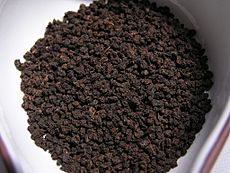Crush, tear, curl facts for kids
Cut, tear, curl (sometimes crush, tear, curl) is a method of processing black tea in which the leaves are passed through a series of cylindrical rollers with hundreds of sharp teeth that crush, tear, and curl the tea into small, hard pellets. This replaces the final stage of orthodox tea manufacture, in which the leaves are rolled into strips. Tea produced using this method is generally called CTC tea or mamri tea.

History
The first CTC machine was brought into service in 1930 at the Amgoorie Tea Garden in Assam under the supervision of Sir William McKercher. It proliferated over three decades starting in 1950, most rapidly in India and Africa.
Production
Today, most black teas produced use the CTC method or the closely related rotorvane orthodox manufacture. CTC and rotovane orthodox have a finished product that is well suited for tea bags, as the product quickly gives a dark brew.
For many large tea producers, 80% to 90% of the factory's production is of small, broken, primary grades suitable for tea bag blends; the remaining 10% to 20% are secondary grades which trade at a discount to the primary grades. The convenience, low price, strong liquor, generic flavor, and mild bitterness all have contributed to the near-monopoly that CTC-type teas now enjoy in South Asia.
In the Indian domestic market, this type of manufacture is by far the most popular – over 80% of tea production is of the CTC type. In the export market, particularly in the C.I.S., the Middle East, United Kingdom and Ireland, CTC teas continue to be the most highly in demand.
CTC teas generally produce a rich red-brown colour when they are boiled by the Indian method. The drawback of the CTC method is that it tends by its nature, and unfortunately by adulteration, to homogenize all black tea flavors. In the process of crushing, tearing and pelletising the tea leaves, pressures and stresses occur which break down the cells, releasing large amounts of the phytins that normally oxidise to produce black tea's mahogany colour. Since, regardless of origin, CTC teas in their dry form are generically "tea-like" in aroma, and of similar pelletized appearance, it is easy to adulterate a more expensive CTC-type tea with inexpensive and generally mild lowland teas of the same process. Whole and broken leaf teas by contrast are quite varied in appearance, making adulteration more difficult.
Disadvantages of CTC Method
The inherited nature of breaking, tearing and crushing, gets homogenizes the taste and aroma of the black tea. As soon as the tea is torn and crushed, the immense pressure reacts to the tea to organically break down tea cells. This broken tea cell fully oxidized now causes the tea to taste hard and strong, but lose its subtlety.
CTC teas are blended in their dry form to create flavor, it can be blended -mixed with multiple inexpensive teas, this makes it difficult to identify the original variety of tea leaves used in the blended tea.
Effectively, whole and broken leaf teas are much difficult to mix with inexpensive teas. If the tea beginning of the CTC process is high quality, the resulting product of CTC tea product will also be good and equivalent quality.


